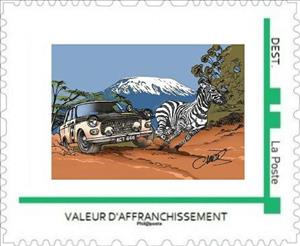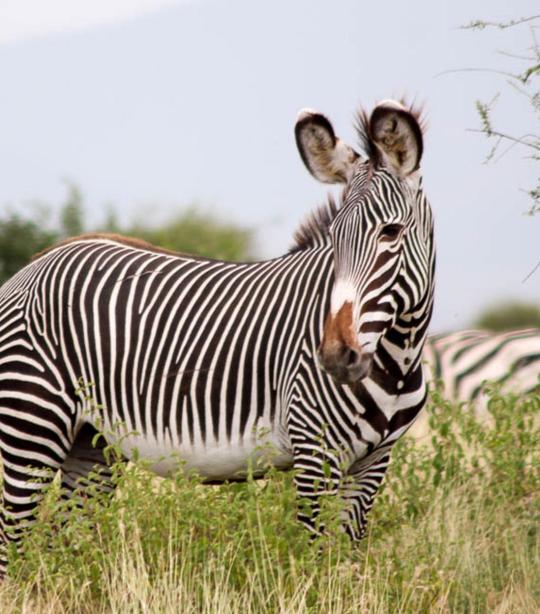Stamp: Cartoon of car and zebra racing by Chris Boyer (France 2019)
Cartoon of car and zebra racing by Chris Boyer (France 2019)
01 January (France ) within release Collectors : Ribambulle goes into circulation Stamp Cartoon of car and zebra racing by Chris Boyer face value Valeur No Face Value
| Stamp Cartoon of car and zebra racing by Chris Boyer in catalogues | |
|---|---|
| Colnect codes: | Col: FR-MON 2019-156 |
Stamp is square format.
Also in the issue Collectors : Ribambulle:
- Stamp - Ballet Dancer by Antonin Gallo face value Valeur;
- Stamp - Bee Alive Cartoon by Thomas Priou face value Valeur;
- Stamp - Boxer by Antonin Gallo face value Valeur;
- Stamp - Cartoon of Alien from the Godillots face value Valeur;
- Stamp - Cartoon of car and zebra racing by Chris Boyer face value Valeur;
- Stamp - Cartoon of Country Animals by Patrice Le Sourd face value Valeur;
- Stamp - Cartoon of Four children in pink by Manboou face value Valeur;
- Stamp - Cartoon of Frog by Bruno Maiorana, Delcourt Ayroles face value Valeur;
- Stamp - Cartoon of little alien by Thibault Colon de Franciosi face value Valeur;
- Stamp - Cartoon of Red Cow Girl by Jackpot face value Valeur;
- Stamp - Cartoon of Ribambulle mascot (crocodile) by Didier Crisse face value Valeur;
- Stamp - Cartoon of Soldier from the Godillots face value Valeur;
- Stamp - Cartoon of Soldier from the Godillots face value Valeur;
- Stamp - Cartoon of Superboy by Mickaël Roux face value Valeur;
- Stamp - Cartoon of Youth from the Godillots face value Valeur;
- Stamp - Cartoon Ribambulle Show Mascot (Crocodile) by Didier Crisse face value Valeur;
- Full Pane - Cartoons of the Godillots by Marko et Olier face value 10*Valeur;
- Stamp - Gymnast by Antonin Gallo face value Valeur;
- Full Pane - Portraits by Antonin Gallo face value 4*Valeur;
- Stamp - Swimmer by Antonin Gallo face value Valeur;
Stamp Cartoon of car and zebra racing by Chris Boyer it reflects the thematic directions:
Art is a diverse range of human activities in creating visual, auditory or performing artifacts (artworks), expressing the author's imaginative or technical skill, intended to be appreciated for their beauty or emotional power. In their most general form these activities include the production of works of art, the criticism of art, the study of the history of art, and the aesthetic dissemination of art. The oldest documented forms of art are visual arts, which include creation of images or objects in fields including painting, sculpture, printmaking, photography, and other visual media. Architecture is often included as one of the visual arts; however, like the decorative arts, or advertising, it involves the creation of objects where the practical considerations of use are essential—in a way that they usually are not in a painting, for example. Music, theatre, film, dance, and other performing arts, as well as literature and other media such as interactive media, are included in a broader definition of art or the arts. Until the 17th century, art referred to any skill or mastery and was not differentiated from crafts or sciences. In modern usage after the 17th century, where aesthetic considerations are paramount, the fine arts are separated and distinguished from acquired skills in general, such as the decorative or applied arts.
A car is a wheeled, self-powered motor vehicle used for transportation and a product of the automotive industry. Most definitions of the term specify that cars are designed to run primarily on roads, to have seating for one to eight people, to typically have four wheels with tyres, and to be constructed principally for the transport of people rather than goods. The year 1886 is regarded as the birth year of the modern car. In that year, German inventor Karl Benz built the Benz Patent-Motorwagen. Cars did not become widely available until the early 20th century. One of the first cars that was accessible to the masses was the 1908 Model T, an American car manufactured by the Ford Motor Company. Cars were rapidly adopted in the United States of America, where they replaced animal-drawn carriages and carts, but took much longer to be accepted in Western Europe and other parts of the world.
A cartoon is a type of visual art that is typically drawn, frequently animated, in an unrealistic or semi-realistic style. The specific meaning has evolved, but the modern usage usually refers to either: an image or series of images intended for satire, caricature, or humor; or a motion picture that relies on a sequence of illustrations for its animation. Someone who creates cartoons in the first sense is called a cartoonist, and in the second sense they are usually called an animator.
The concept originated in the Middle Ages, and first described a preparatory drawing for a piece of art, such as a painting, fresco, tapestry, or stained glass window. In the 19th century, beginning in Punch magazine in 1843, cartoon came to refer – ironically at first – to humorous artworks in magazines and newspapers. Then it also was used for political cartoons and comic strips. When the medium developed, in the early 20th century, it began to refer to animated films that resembled print cartoons.
Zebras (US: /ˈziːbrəz/, UK: /ˈzɛbrəz, ˈziː-/) (subgenus Hippotigris) are African equines with distinctive black-and-white striped coats. There are three living species: Grévy's zebra (Equus grevyi), the plains zebra (E. quagga), and the mountain zebra (E. zebra). Zebras share the genus Equus with horses and asses, the three groups being the only living members of the family Equidae. Zebra stripes come in different patterns, unique to each individual. Several theories have been proposed for the function of these patterns, with most evidence supporting them as a deterrent for biting flies. Zebras inhabit eastern and southern Africa and can be found in a variety of habitats such as savannahs, grasslands, woodlands, shrublands, and mountainous areas




